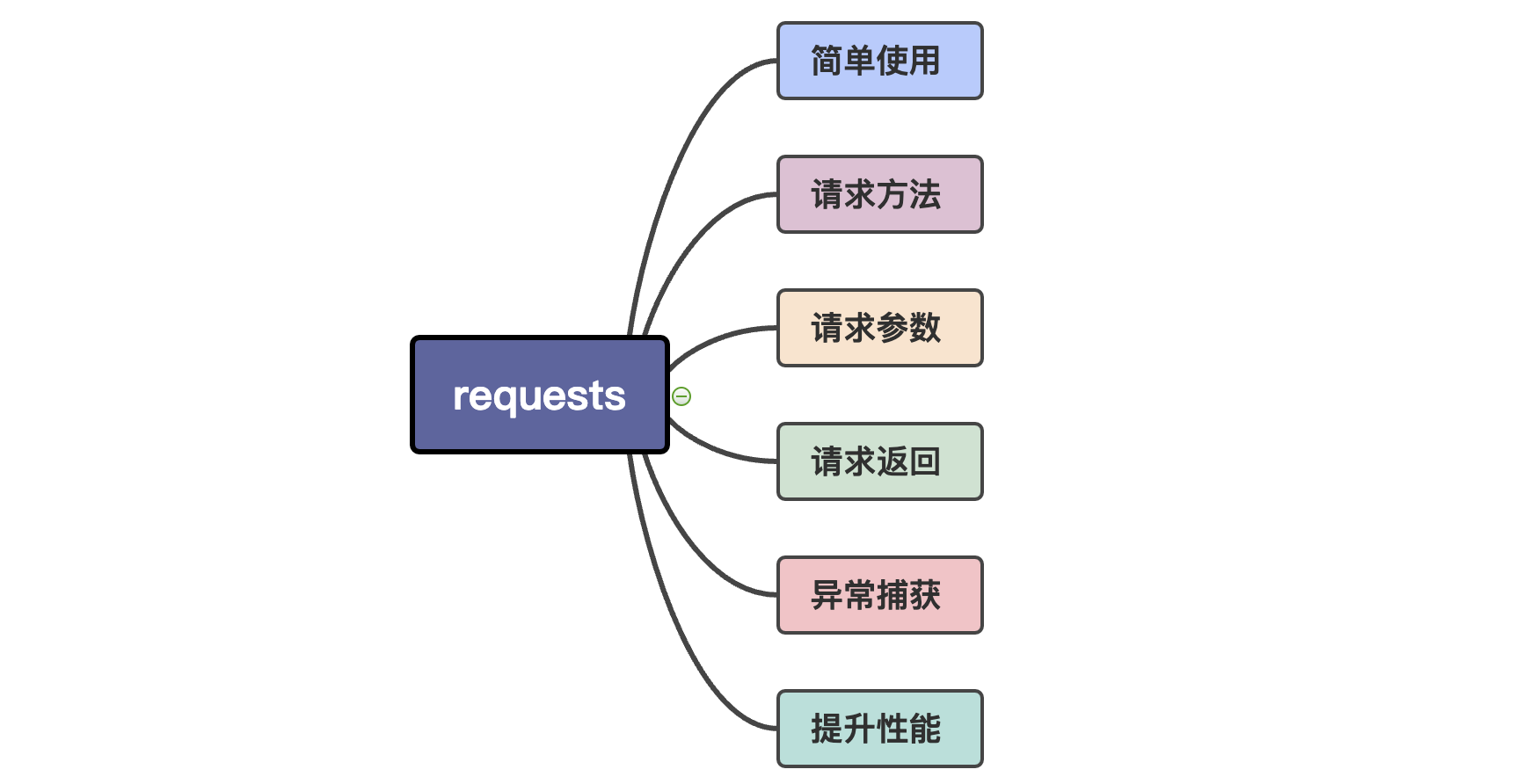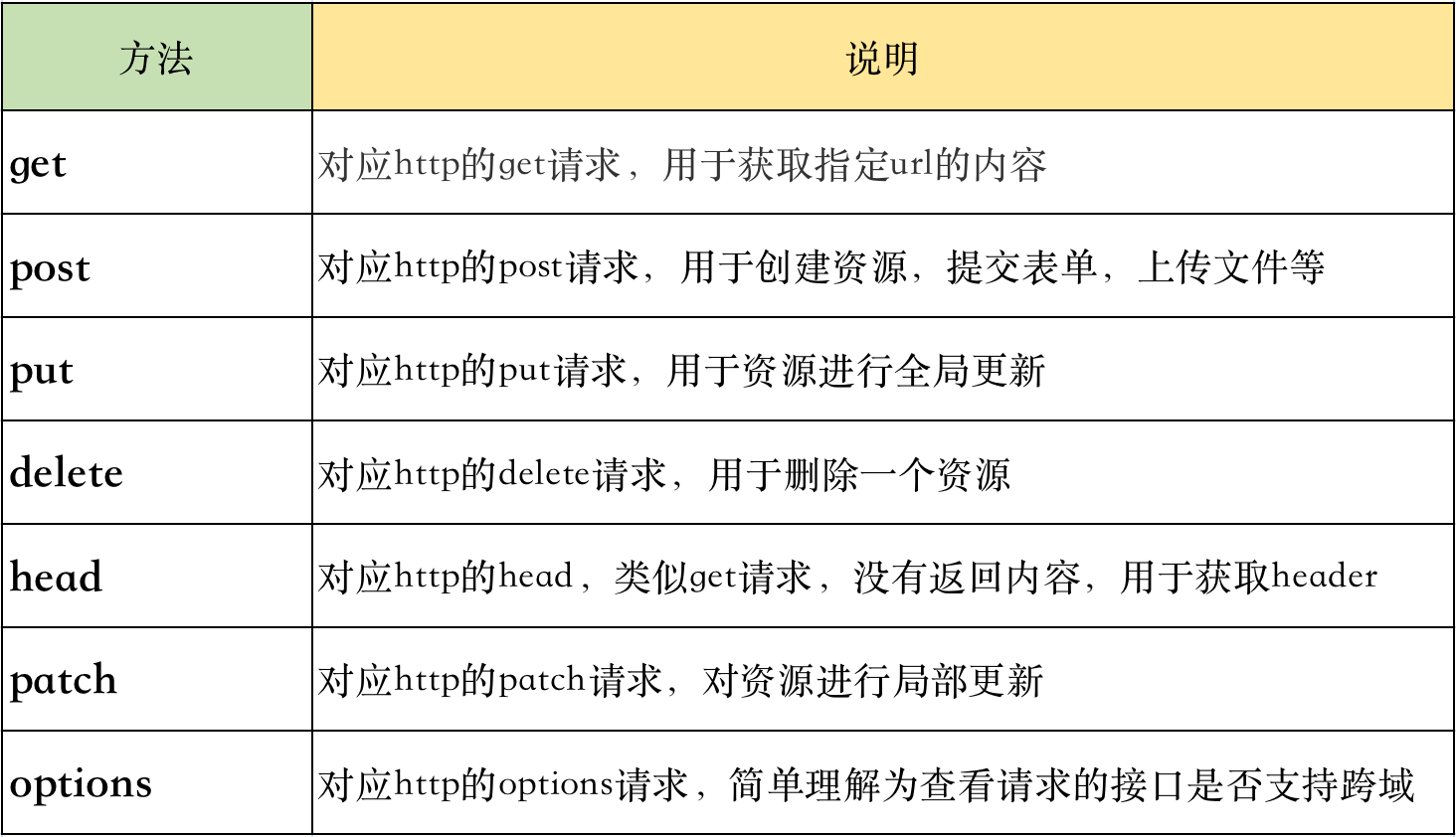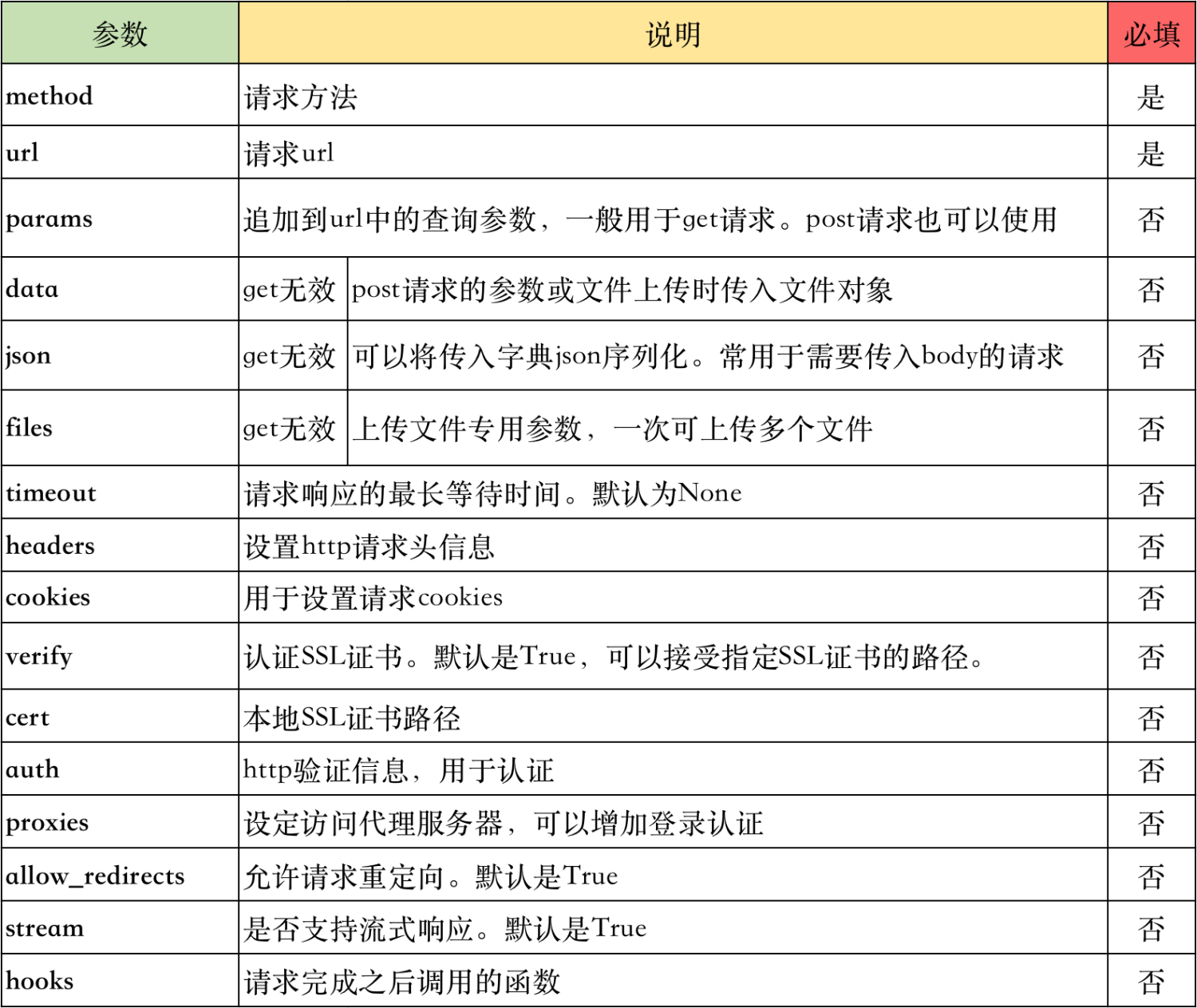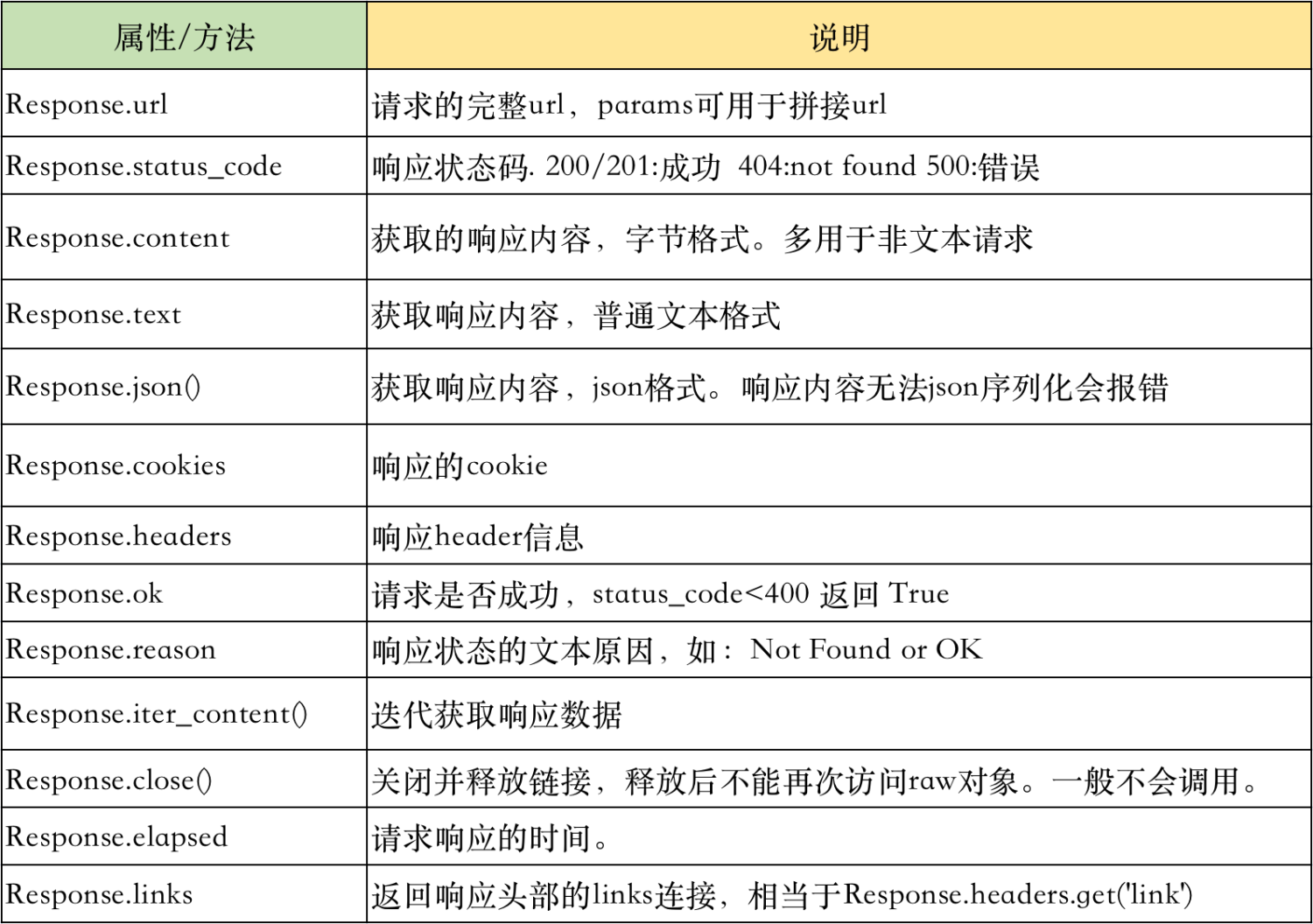requests Python中最好用的網路請求工具 基礎速記+最佳實踐

簡介
requests 模組是寫python指令碼使用頻率最高的模組之一。很多人寫python第一個使用的模組就是requests,因為它可以做網路爬蟲。不僅寫爬蟲方便,在日常的開發中更是少不了requests的使用。如呼叫後端介面,上傳檔案,查詢資料庫等。本篇詳細介紹requests的使用。
requests 是⽤Python編寫的第三方庫,它基於python自帶網路庫urllib3封裝完成。採⽤Apache2 Licensed開源協定的 HTTP 庫。它⽐ urllib3 更加⽅便,可以節約使用者⼤量的時間。
下面從如下6個方面,全面講解requests模組
- 簡單使用
- 請求方法
- 請求引數
- 請求返回
- 異常捕獲
- 提升效能
功能快速傳送門
不需要看完全篇內容,直接跳轉到需要查詢的功能
上傳檔案: 請求引數->files使用
認證介面呼叫:請求引數->header使用
json介面呼叫:請求引數->json使用
form表單介面呼叫:請求引數->data使用
requests初識
requests 是一個第三方庫,使用之前需要安裝。安裝命令如下:
pip3 install requests -i https://pypi.tuna.tsinghua.edu.cn/simple
最簡單請求,傳送一個get請求,獲得返回值。
import requests
res = requests.get("http://www.baidu.com")
print(res)
>>>
<Response [200]>
從如上程式碼可以看出,使用requets傳送請求只需要一行程式碼就可以搞定,是非常簡單的事情。而requests的設計理念就是 **Requests** is an elegant and simple HTTP library for Python, built for human beings.意思就是:requests是一個優雅而簡單的 Python HTTP 庫,它是為人類構建的。
由於不同版本之間引數和功能略有差異,所以說明本文使用的requests版本是 2.31.0
請求方法
requests支援大部分的HTTP請求方法。具體如下:

關於每一個請求方法的使用下面一一列舉出來。以下範例基於本地啟動的後端服務,嘗試跑範例請更換url。
get請求獲取記錄
import requests
url = "http://127.0.0.1:8090/demos"
res = requests.get(url)
print(res.json()) # 返回json反序列化之後的字典物件
>>>
{'result': [{'age': 0, 'create_at': 'Mon, 29 May 2023 22:05:40 GMT', 'id': 2, 'name': 'string', 'status': 0, 'update_at': 'Mon, 29 May 2023 22:05:40 GMT', 'user_id': 0}, {'age': 100, 'create_at': 'Sun, 11 Jun 2023 10:38:28 GMT', 'id': 3, 'name': 'ljk', 'status': 0, 'update_at': 'Sun, 11 Jun 2023 10:38:28 GMT', 'user_id': 223}], 'total': 2}
post請求建立記錄
import requests
url = "http://127.0.0.1:8090/demo"
payload = {
"age": 18,
"desc": "post_demo",
"name": "post_method",
"user_id": 102
}
# body體會自動json序列化
res = requests.post(url, json=payload)
print(res.json())
>>>
{'age': 18, 'create_at': 'Sun, 11 Jun 2023 16:14:40 GMT', 'id': 4, 'name': 'post_method', 'status': 0, 'update_at': 'Sun, 11 Jun 2023 16:14:40 GMT', 'user_id': 102}
put請求更新記錄
import requests
url = "http://127.0.0.1:8090/demo/4"
payload = {
"age": 20,
"user_id": 1001
}
res = requests.put(url, json=payload)
print(res.json())
>>>
{'msg': 'success'}
delete請求刪除記錄
import requests
url = "http://127.0.0.1:8090/demo/4"
res = requests.delete(url)
print(res.json())
>>>
{'msg': 'success'}
head請求獲取header
import requests
url = "http://127.0.0.1:8090/demos"
res = requests.head(url)
print(res.ok)
print(res.headers)
>>>
ok
{'Server': 'Werkzeug/2.3.6 Python/3.9.6', 'Date': 'Sat, 17 Jun 2023 06:34:44 GMT', 'Content-Type': 'application/json', 'Content-Length': '702', 'Connection': 'close'}
從返回結果的headers中可以找到返回的資料型別 'Content-Type': 'application/json',這說明返回的資料是json編碼格式的,所以需要json反序列化之後才能使用。
patch請求更新部分資料
import requests
url = "http://127.0.0.1:8090/demo/4"
payload = {
"age": 200
}
res = requests.patch(url, json=payload)
print(res.json())
'''
{'msg': 'success'}
'''
options請求檢視介面要求
import requests
url = "http://127.0.0.1:8090/demo/4"
headers={
"Access-Control-Request-Method": "GET",
"Origin": "*",
"Access-Control-Request-Headers": "Authorization",
}
res = requests.options(url, headers=headers)
print(res.ok)
print(res.headers)
>>>
True
{'Server': 'Werkzeug/2.3.6 Python/3.9.6', 'Date': 'Sat, 17 Jun 2023 06:38:21 GMT', 'Content-Type': 'text/html; charset=utf-8', 'Allow': 'OPTIONS, DELETE, PUT, PATCH, HEAD, GET', 'Content-Length': '0', 'Connection': 'close'}
從返回的headers中可以看到,該介面允許的請求包括:'Allow': 'OPTIONS, DELETE, PUT, PATCH, HEAD, GET',所以該介面可以使用允許的方法去存取。相反沒有允許的方法是無法存取的該介面的。
請求引數
request 請求的函數簽名如下,可以看出requests支援非常多的引數。截止當前版本2.31.0一共16個引數。
def request(
self,
method,
url,
params=None,
data=None,
headers=None,
cookies=None,
files=None,
auth=None,
timeout=None,
allow_redirects=True,
proxies=None,
hooks=None,
stream=None,
verify=None,
cert=None,
json=None,
):
引數說明:

params 使用範例
功能:拼接請求url
在get請求中如果攜帶查詢引數如分頁查詢
http://127.0.0.1:8090/demos?offset=10&limint=10
查詢部分的引數有兩種寫法,第一是直接拼接成如上的url,另一種寫法是使用params引數。
將查詢的引數定義為字典,傳入到params中。
url = "http://127.0.0.1:8090/demos"
res = requests.get(url, params={"offset": 1, "limit": 10})
print(res.json())
print(res.url) # 返回請求的url
>>>
{'result': [{'age': 200, 'create_at': 'Sun, 11 Jun 2023 10:38:28 GMT', 'id': 3, 'name': 'ljk', 'status': 0, 'update_at': 'Sun, 11 Jun 2023 10:38:28 GMT', 'user_id': 1002}], 'total': 2}
http://127.0.0.1:8090/demos?offset=1&limit=10
請求返回物件有一個url屬性,可以展示請求的方法。可以看到params將傳入的字典追加到url當中。
data 使用範例
功能:儲存請求body體、上傳檔案
使用data傳送一個body是json格式的請求,首先設定header中資料格式為json,然後使用json序列化body。
import json
import requests
url = "http://127.0.0.1:8090/demo"
payload = {
"age": 18,
"desc": "post_demo",
"name": "post_method",
"user_id": 102
}
headers = {"Content-Type": "application/json"}
res = requests.post(url, data=json.dumps(payload), headers=headers)
print(res.json())
知識加油站:
Content-Type欄位:
header 頭部資訊中有一個 Content-Type 欄位,該欄位用於使用者端告訴伺服器實際傳送的資料型別,比如傳送的資料可以是檔案、純文字、json字串、表單等。在requests中常用的資料型別有5種:
- application/x-www-form-urlencoded:form表單資料被編碼為key/value格式傳送到伺服器。請求預設格式
- multipart/form-data:不僅可以傳輸引數,還可以傳輸檔案
- text/xml : XML格式。傳送的資料必須是xml格式
- application/json:json 格式。傳送的資料必須是json格式
- text/plain :純文字格式
form-data 提交資料的介面
某些介面需要傳送multipart/form-data型別的資料,有兩種方法:
- 手動組建form-data並修改headers
- 通過files引數傳遞form-data,推薦此種方式
手動組建form-data
import requests
url = "http://www.demo.com/"
payload = """------WebKitFormBoundary7MA4YWxkTrZu0gW\r\nContent-Disposition: form-data;
name=\"phone\"\n\n{}\r\n------WebKitFormBoundary7MA4YWxkTrZu0gW\r\nContent-Disposition: form-data;
name=\"idnum\"\n\n{}\r\n------WebKitFormBoundary7MA4YWxkTrZu0gW\r\nContent-Disposition: form-data;
name=\"name\"\r\n\r\n{}\r\n------WebKitFormBoundary7MA4YWxkTrZu0gW\r\nContent-Disposition: form-data;
name=\"products\"\r\n\r\n {}\r\n------WebKitFormBoundary7MA4YWxkTrZu0gW--""".format(12374658756, 23, "demo", [201,])
headers = {
"content-type": "multipart/form-data; boundary=----WebKitFormBoundary7MA4YWxkTrZu0gW"
}
resp = requests.post(url, data=payload, verify=False, headers=headers)
通過files傳遞
import requests
files = {
'schoolId': (None, -1),
'schoolName': (None, ""),
"reward": (None, 5),
"publishText": (None, "測試測試"),
"tags": (None, 1),
'image': ('image.jpg', open('%s/resource/upload_images/image.jpg' % PATH_DIR, 'rb'), 'application/octet-stream')
}
response = requests.post(url, files=files)
json 使用範例
功能:儲存body體並json序列化
後端介面接受json格式的資料,除了使用json.dumps序列化body之後,使用json引數是更方便的選擇。json引數會自動將傳入的字典序列化並新增json格式的頭資訊。
import requests
url = "http://127.0.0.1:8090/demo"
payload = {
"age": 18,
"desc": "post_demo",
"name": "post_method",
"user_id": 102
}
res = requests.post(url, json=payload)
print(res.json())
header 使用範例
功能:儲存header資訊,可用於偽裝瀏覽器,攜帶認證資訊等
公共介面為了反爬蟲都會校驗請求頭裡的資訊,非瀏覽器的請求會被拒絕。使用特定的headers資訊即可將指令碼偽裝成瀏覽器。
介面中通常需要校驗認證資訊,需要攜帶token發起請求,token就需要再headers中指定。
import requests
url = "http://127.0.0.1:8090/demo"
headers = {
'User-Agent':'Mozilla/5.0 (Macintosh; Intel Mac OS X 10_15_7) AppleWebKit/537.36 (KHTML, like Gecko) Chrome/114.0.0.0 Safari/537.36'
'mtk': "xxxxx"
}
res = requests.get(url, headers=headers)
print(res.json())
files 使用範例
功能:上傳檔案
上傳檔案首先開啟一個檔案獲得檔案控制程式碼,然後傳入files中。可以上傳一個或多個檔案。
建議使用二進位制的方式讀取檔案,requests 可能會為你提供 header 中的 Content-Length。
import requests
url = "http://127.0.0.1:8090/demo"
filea = open("a.txt", "rb")
fileb = open("b.txt", "rb")
res = requests.post(url, files={"file_a": filea, "file_b": fileb})
print(res.json())
timeout 使用範例
功能:指定請求的超時時間
超時可分為連線超時和讀取超時
分別設定連線超時和讀取超時,timeout=(連線超時時間, 讀取超時時間)
統一設定連線超時和讀取超時, timeout=超時時間
url = "http://127.0.0.1:8090/demo/10"
res = requests.get(url, timeout=(3, 10))
print(res.json())
hooks 使用範例
功能:新增勾點函數
Hooks即勾點方法,用於在某個流程執行時捎帶執行另一個自定義的方法。
requests庫只支援一個response的勾點,在響應返回時可以捎帶執行我們自定義的某些方法。可以用於列印一些資訊,做一些響應檢查或在響應物件中新增額外的資訊。
import requests
def verify_res(res, *args, **kwargs):
res.status = 'PASS' if res.status_code == 200 else 'FAIL'
print(res.status)
url = "http://www.baiu.com"
response = requests.get(url, hooks={'response': verify_res})
print("result_url " + response.url)
除了為某一個請求自定義勾點之外,還可以給所有請求都自定勾點函數。
# 建立自定義請求物件時,修改全域性模組丟擲錯誤異常
seesion = requests.Session()
def hook_func():
pass
http.hooks["response"] = [hook_func]
session.get("xxx")
返回物件
每一次請求都需要獲取詳細準確的返回結果,requests請求返回的是一個response物件,該物件有豐富的屬性和方法。

content、text、json() 的區別
content 返回是的二進位制的內容,text返回是字串格式的內容,json()返回的是序列化的內容。
import requests
url = "http://127.0.0.1:8090/demo/5"
res = requests.get(url)
print(f"content型別 -> type: {type(res.content)}\n 內容: {res.content}")
print(f"text型別 -> type: {type(res.text)}\n 內容: {res.text}")
print(f"json()型別 -> type: {type(res.json())}\n 內容: {res.json()}")
>>>
content型別 -> type: <class 'bytes'>
內容: b'{\n "age": 18,\n "id": 5,\n "name": "post_method",\n "status": 0,\n "user_id": 102\n}\n'
text型別 -> type: <class 'str'>
內容: {
"age": 18,
"id": 5,
"name": "post_method",
"status": 0,
"user_id": 102
}
json()型別 -> type: <class 'dict'>
內容: {'age': 18, 'id': 5, 'name': 'post_method', 'status': 0, 'user_id': 102}
從以上返回結果的型別可以清晰看出三者之間的不同。通常介面返回json格式的資料比較好處理。
推薦使用:
- 確切知道介面返回的json格式的字串,使用response.json()獲取結果
- 不知道介面返回的資料格式,使用response.text獲取結果
status_code 和 ok
status_code 是介面的標準響應碼,ok 是表示一個請求是否正常。關於正常的定義可以參見ok函數的函數說明。
@property
def ok(self):
"""Returns True if :attr:`status_code` is less than 400, False if not.
import requests
url = "http://127.0.0.1:8090/demo/5"
res = requests.get(url)
print(f"狀態碼:{res.status_code}, 是否ok: {res.ok}")
url = "http://127.0.0.1:8090/demo/10"
res = requests.get(url)
print(f"狀態碼:{res.status_code}, 是否ok: {res.ok}")
>>>
狀態碼:200, 是否ok: True
狀態碼:404, 是否ok: False
介面標準響應碼:
- 資訊響應 (100–199)
- 成功響應 (200–299)
- 重定向訊息 (300–399)
- 使用者端錯誤響應 (400–499)
- 伺服器端錯誤響應 (500–599)
reason 簡要結果說明
reason 可以獲取請求的簡單結果描述。200的結果是200,非200的結果都會有一個簡潔的說明。
import requests
url = "http://127.0.0.1:8090/demo/5"
res = requests.get(url)
print(f"狀態碼:{res.status_code}, reason: {res.reason}")
>>>
狀態碼:404, reason: NOT FOUND
url = "http://127.0.0.1:8090/demo/5"
res = requests.get(url)
print(f"狀態碼:{res.status_code}, reason: {res.reason}")
>>>
狀態碼:500, reason: INTERNAL SERVER ERROR
header 和 cookies 的展示
在呼叫需要登陸的介面可能需要認證之後的cookies和header中某些特殊欄位,所以在請求返回中通過header和cookies拿到相應的引數。
import requests
url = "http://127.0.0.1:8090/demo/5"
res = requests.get(url)
print(f"header: {res.headers}")
print(f"cookies: {res.cookies}")
>>>
header: {'Server': 'Werkzeug/2.3.6 Python/3.9.6', 'Date': 'Tue, 13 Jun 2023 13:27:13 GMT', 'Content-Type': 'application/json', 'Content-Length': '85', 'Connection': 'close'}
cookies: <RequestsCookieJar[]>
異常捕獲
網路請求通常會存在很多可能的錯誤,特別是http請求還有複雜的後端介面。所以對於錯誤資訊的捕獲就特別重要,合理的捕獲異常資訊可以極大的增強程式碼的及健壯性。requests 提供了多種異常庫,包括如下:
class RequestException(IOError):
pass
class InvalidJSONError(RequestException):
pass
class JSONDecodeError(InvalidJSONError, CompatJSONDecodeError):
pass
class HTTPError(RequestException):
pass
class ConnectionError(RequestException):
pass
class ProxyError(ConnectionError):
pass
class SSLError(ConnectionError):
pass
class Timeout(RequestException):
pass
class ConnectTimeout(ConnectionError, Timeout):
pass
class ReadTimeout(Timeout):
pass
class URLRequired(RequestException):
pass
class TooManyRedirects(RequestException):
pass
class MissingSchema(RequestException, ValueError):
pass
class InvalidSchema(RequestException, ValueError):
pass
class class InvalidURL(RequestException, ValueError):
pass
class InvalidHeader(RequestException, ValueError):
pass
class InvalidProxyURL(InvalidURL):
pass
class ChunkedEncodingError(RequestException):
pass
class ContentDecodingError(RequestException, BaseHTTPError):
pass
class StreamConsumedError(RequestException, TypeError):
pass
class RetryError(RequestException):
pass
class UnrewindableBodyError(RequestException):
pass
挑選最常用的幾個異常加以說明

未捕獲異常
沒有捕獲異常,當異常發生時最後會導致程式異常退出。
url = "http://127.0.0.1:8090/demo/10"
res = requests.get(url)
>>>
Traceback (most recent call last):
File "/Users/ljk/Documents/python_env/dev/lib/python3.9/site-packages/urllib3/connection.py", line 174, in _new_conn
conn = connection.create_connection(
File "/Users/ljk/Documents/python_env/dev/lib/python3.9/site-packages/urllib3/util/connection.py", line 95, in create_connection
raise err
File "/Users/ljk/Documents/python_env/dev/lib/python3.9/site-packages/urllib3/util/connection.py", line 85, in create_connection
sock.connect(sa)
ConnectionRefusedError: [Errno 61] Connection refused
RequestException
RequestException 可以捕獲requests請求所有的異常,是最大顆粒度的異常。
import requests
url = "http://127.0.0.1:8090/demo/10"
try:
res = requests.get(url)
except requests.exceptions.RequestException as e:
print("something error:")
print(e)
else:
print(f"狀態碼:{res.status_code}, 是否ok: {res.ok}")
finally:
print("request end")
>>>
something error:
HTTPConnectionPool(host='127.0.0.1', port=8090): Max retries exceeded with url: /demo/10 (Caused by NewConnectionError('<urllib3.connection.HTTPConnection object at 0x1035db790>: Failed to establish a new connection: [Errno 61] Connection refused'))
request end
ConnectionError
ConnectionError 可以捕獲請求中網路相關的錯誤,如網路不可達,拒絕連線等。使用ConnectionError捕獲到拒絕連線的錯誤。
import requests
url = "http://127.0.0.1:8090/demo/10"
try:
res = requests.get(url, timeout=1)
except requests.exceptions.ConnectionError as e:
print("something error:")
print(e)
else:
print(f"狀態碼:{res.status_code}, 是否ok: {res.ok}")
finally:
print("request end")
>>>
something error:
HTTPConnectionPool(host='127.0.0.1', port=8090): Max retries exceeded with url: /demo/10 (Caused by NewConnectionError('<urllib3.connection.HTTPConnection object at 0x103833880>: Failed to establish a new connection: [Errno 61] Connection refused'))
request end
ConnectTimeout
請求拒絕是對端伺服器收到了請求但是拒絕連線,而ConnectTimeout是沒有和對端伺服器建立連線而超時。
import requests
url = "http://www.facebook.com"
try:
res = requests.get(url, timeout=10)
except requests.exceptions.ConnectTimeout as e:
print("something error:")
import pdb
pdb.set_trace()
print(e)
else:
print(f"狀態碼:{res.status_code}, 是否ok: {res.ok}")
finally:
print("request end")
>>>
something error:
HTTPConnectionPool(host='www.facebook.com', port=80): Max retries exceeded with url: / (Caused by ConnectTimeoutError(<urllib3.connection.HTTPConnection object at 0x1056d28b0>, 'Connection to www.facebook.com timed out. (connect timeout=10)'))
request end
ReadTimeout
ReadTimeout 是和對端伺服器建立了連線,介面返回時超時。在請求介面中睡眠10s,人為製造一個讀取超時。
class Demo(MethodView):
@swag_from("./apidocs/get.yml")
def get(self, demo_id):
"""獲取單個demo資料"""
# 直接查詢資料庫也可,封裝成函數可以做一些快取
import time
time.sleep(5)
demo = DemoTable.get_by_demo_id(demo_id)
return json_response(data=demo.to_dict())
import requests
url = "http://127.0.0.1:8090/demo/10"
try:
res = requests.get(url, timeout=1)
except requests.exceptions.ReadTimeout as e:
print("something error:")
print(e)
else:
print(f"狀態碼:{res.status_code}, 是否ok: {res.ok}")
finally:
print("request end")
>>>
something error:
HTTPConnectionPool(host='127.0.0.1', port=8090): Read timed out. (read timeout=1)
request end
介面錯誤的例外處理
requests請求中所有的介面本身出錯都不會丟擲異常,比如介面404,500,502等都不會主動丟擲異常,而是通過異常狀態碼展示出來。
import requests
url = "http://127.0.0.1:8090/demo/10"
try:
res = requests.get(url, timeout=10)
except requests.exceptions.RequestException as e:
print("something error:")
print(e)
else:
print(f"狀態碼:{res.status_code}, 是否ok: {res.ok}")
finally:
print("request end")
>>>
狀態碼:404, 是否ok: False
request end
狀態碼:502, 是否ok: False
request end
可以看到使用最大返回的異常捕獲也沒有捕獲到介面相關的異常,所以介面異常需要通過status_code狀態碼去判斷。
狀態碼有很多,如果不想寫很多if else判斷語句,可以使用 response.raise_for_status() 來丟擲異常。raise_for_status() 是一個類似斷言assert的方法,如果請求不是200就丟擲一個異常。
import requests
url = "http://127.0.0.1:8090/demo/10"
res = requests.get(url, timeout=5)
res.raise_for_status()
print(res.json())
>>>
Traceback (most recent call last):
File "/Users/ljk/Documents/code/daily_dev/requests_demo/method_demo.py", line 166, in <module>
res.raise_for_status()
File "/Users/ljk/Documents/python_env/dev/lib/python3.9/site-packages/requests/models.py", line 1021, in raise_for_status
raise HTTPError(http_error_msg, response=self)
requests.exceptions.HTTPError: 404 Client Error: NOT FOUND for url: http://127.0.0.1:8090/demo/10
提高請求效率的方法
多執行緒
低效的請求:
當有大量的請求任務時使用for迴圈逐個遍歷請求是非常低效的實現。網路IO最耗時的地方便是等待請求的返回,而for迴圈是順序執行,只有在前一個請求返回之後才能繼續下一個,大量的時間都浪費在網路等待中。
多執行緒優化:
使用多執行緒能夠顯著提高程式碼效率,減少請求耗時。原理是:python的多執行緒在遇到網路請求時會主動讓CPU,所以當大量請求執行緒執行時,一個執行緒遇到網路請求就讓出CPU給其他執行緒使用,不會阻塞等待請求返回。這樣大量請求都能同一時間傳送出去。
for迴圈請求和多執行緒請求對比:
import time
import threading
import requests
# for迴圈
start = time.time()
for i in range(10):
res = requests.get("https://www.csdn.net/", timeout=3)
end = time.time()
print(f"總計耗時:{end-start}")
# 多執行緒
def get_request():
res = requests.get("https://www.csdn.net/", timeout=3)
start = time.time()
t_list = []
for i in range(10):
t = threading.Thread(target=get_request)
t_list.append(t)
t.start()
for t in t_list:
t.join()
end = time.time()
print(f"總計耗時:{end-start}")
>>>
總計耗時:6.254332065582275
總計耗時:0.740969181060791
可以看出多執行緒的耗時幾乎是for迴圈的10分之一,將整體的請求耗時降低了一個層級。
在多執行緒請求時如果執行緒超過10個,比較推薦使用執行緒池的技術,能夠有效減少執行緒的建立耗時。
from concurrent.futures import ThreadPoolExecutor
def get_request():
res = requests.get("https://www.csdn.net/", timeout=3)
with ThreadPoolExecutor(max_workers=2) as pool:
for i in range(10):
pool.submit(get_request)
複用TCP鏈路
每呼叫一次requests方法請求一次目標伺服器,本地機器和目標伺服器之間都會建立一次TCP連線,然後傳輸http請求的資料。在發起大量請求的情況下建立過多的tcp連線不僅會導致程式碼耗時增加,而且會讓目標伺服器承受網路讀寫壓力。
使用session可以做到多個請求共用一個TCP連線,在大量請求的場景下能夠有效減少程式碼耗時和降低目標伺服器壓力。
使用session非常簡單,只需要多做一步範例化一個session物件即可,範例如下:
# 初始化一個session物件,相當於建立一個tcp連線
s = requests.Session()
for i in range(100):
res = s.get(f'https://www.target.com/i')
print(res.text)
# 另一種使用方法
with requests.Session() as s:
s.get('https://httpbin.org/get')
普通請求和複用tcp連線請求耗時對比:
import threading
# 普通連線
def get_request():
res = requests.get("https://www.csdn.net/", timeout=3)
start = time.time()
t_list = []
for i in range(10):
t = threading.Thread(target=get_request)
t_list.append(t)
t.start()
for t in t_list:
t.join()
end = time.time()
print(f"總計耗時:{end-start}")
# 複用tcp連線
def get_request_session(s):
res = s.get("https://www.csdn.net/", timeout=3)
start = time.time()
t_list = []
with requests.Session() as s:
for i in range(10):
t = threading.Thread(target=get_request_session, args=(s,))
t_list.append(t)
t.start()
for t in t_list:
t.join()
end = time.time()
print(f"總計耗時:{end-start}")
>>>
總計耗時:0.9967081546783447
總計耗時:0.7688210010528564
可以看出,複用TCP之後速度有更進一步的提升。
重試機制
通常在一次請求中如果超時了還會重試幾次,實現重試邏輯通常會使用一個記次的邏輯。可能會寫出如下的程式碼:
i = 0
while i < 3:
try:
res = requests.get(url, timeout=5)
break
except requests.exceptions.Timeout:
i += 1
其實重試的功能requests已經提供了。requests提供了一個傳輸介面卡的方法完成一些如重試機制、心跳檢測等功能能。
重試機制:
每當 Session 被初始化,就會有預設的介面卡附著在 Session 上,其中一個供 HTTP 使用,另一個供 HTTPS 使用。requests允許使用者建立和使用他們自己的傳輸介面卡,實現他們需要的特殊功能。範例如下:
import time
from requests.adapters import HTTPAdapter
s = requests.Session()
# 為session新增介面卡。根據url是否為https選擇一個即可
s.mount('http://', HTTPAdapter(max_retries=3))
s.mount('https://', HTTPAdapter(max_retries=3))
start = time.time()
try:
res = s.get('http://www.facebook.com', timeout=5)
print(res.text)
except requests.exceptions.Timeout as e:
print(e)
end = time.time()
print(end-start)
>>>
HTTPConnectionPool(host='www.facebook.com', port=80): Max retries exceeded with url: / (Caused by ConnectTimeoutError(<urllib3.connection.HTTPConnection object at 0x10538f0d0>, 'Connection to www.facebook.com timed out. (connect timeout=5)'))
20.0400869846344
說明:
以上程式碼一共耗時20s,然後丟擲異常。一次正常的請求加上三次重試,每次5s超時,所以是20s。三次之後請求還是超時,丟擲timeout的異常並被捕獲到。
附錄 resquests 最核心程式碼
def send(
self, request, stream=False, timeout=None, verify=True, cert=None, proxies=None
):
"""Sends PreparedRequest object. Returns Response object.
:param request: The :class:`PreparedRequest <PreparedRequest>` being sent.
:param stream: (optional) Whether to stream the request content.
:param timeout: (optional) How long to wait for the server to send
data before giving up, as a float, or a :ref:`(connect timeout,
read timeout) <timeouts>` tuple.
:type timeout: float or tuple or urllib3 Timeout object
:param verify: (optional) Either a boolean, in which case it controls whether
we verify the server's TLS certificate, or a string, in which case it
must be a path to a CA bundle to use
:param cert: (optional) Any user-provided SSL certificate to be trusted.
:param proxies: (optional) The proxies dictionary to apply to the request.
:rtype: requests.Response
"""
try:
conn = self.get_connection(request.url, proxies)
except LocationValueError as e:
raise InvalidURL(e, request=request)
self.cert_verify(conn, request.url, verify, cert)
url = self.request_url(request, proxies)
self.add_headers(
request,
stream=stream,
timeout=timeout,
verify=verify,
cert=cert,
proxies=proxies,
)
chunked = not (request.body is None or "Content-Length" in request.headers)
if isinstance(timeout, tuple):
try:
connect, read = timeout
timeout = TimeoutSauce(connect=connect, read=read)
except ValueError:
raise ValueError(
f"Invalid timeout {timeout}. Pass a (connect, read) timeout tuple, "
f"or a single float to set both timeouts to the same value."
)
elif isinstance(timeout, TimeoutSauce):
pass
else:
timeout = TimeoutSauce(connect=timeout, read=timeout)
try:
resp = conn.urlopen(
method=request.method,
url=url,
body=request.body,
headers=request.headers,
redirect=False,
assert_same_host=False,
preload_content=False,
decode_content=False,
retries=self.max_retries,
timeout=timeout,
chunked=chunked,
)
except (ProtocolError, OSError) as err:
raise ConnectionError(err, request=request)
except MaxRetryError as e:
if isinstance(e.reason, ConnectTimeoutError):
# TODO: Remove this in 3.0.0: see #2811
if not isinstance(e.reason, NewConnectionError):
raise ConnectTimeout(e, request=request)
if isinstance(e.reason, ResponseError):
raise RetryError(e, request=request)
if isinstance(e.reason, _ProxyError):
raise ProxyError(e, request=request)
if isinstance(e.reason, _SSLError):
# This branch is for urllib3 v1.22 and later.
raise SSLError(e, request=request)
raise ConnectionError(e, request=request)
except ClosedPoolError as e:
raise ConnectionError(e, request=request)
except _ProxyError as e:
raise ProxyError(e)
except (_SSLError, _HTTPError) as e:
if isinstance(e, _SSLError):
# This branch is for urllib3 versions earlier than v1.22
raise SSLError(e, request=request)
elif isinstance(e, ReadTimeoutError):
raise ReadTimeout(e, request=request)
elif isinstance(e, _InvalidHeader):
raise InvalidHeader(e, request=request)
else:
raise
return self.build_response(request, resp)